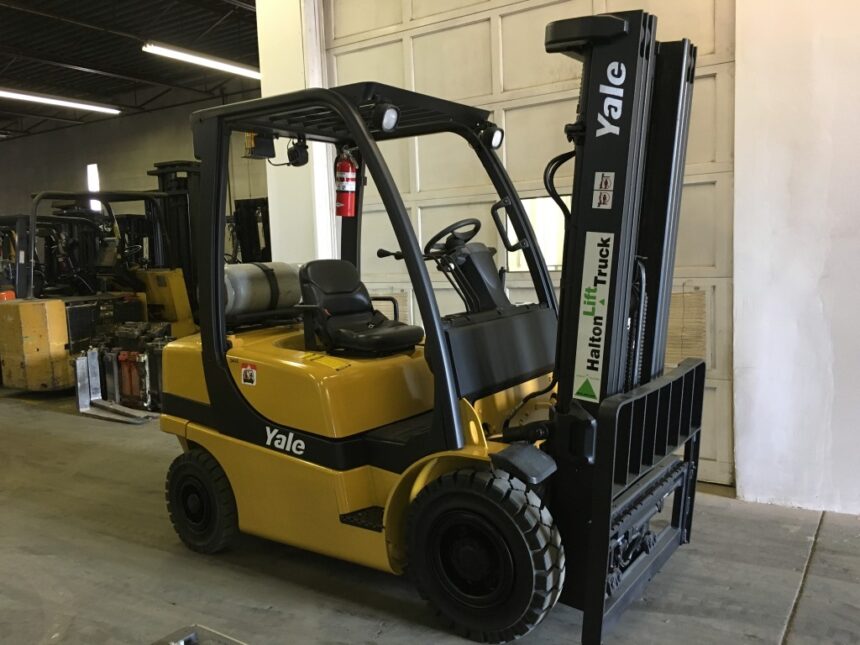Introduction
The Yale GLP050VX TOSS Sensor is not just another component, it’s a crucial element in the safety and efficiency of forklift operations. Whether you’re in a warehouse, distribution center, or manufacturing plant, this Sensor is your silent guardian, ensuring that the Forklift operates within safe load and tilt parameters. However, like any electronic component, the TOSS sensor can face issues over time. This article aims to provide a comprehensive guide on troubleshooting the most common problems you might encounter with the Yale GLP050VX TOSS sensor.
What is the Yale GLP050VX TOSS Sensor? To ensure that all readers, regardless of their technical background, understand the technical terms used in this manual, a glossary of technical terms is provided at the end of this document.
The Yale GLP050VX TOSS sensor is a specialized device used in Yale forklifts to monitor the tilt angle and overload of the vehicle. The TOSS (Tilt and Overload Sensor System) is designed to ensure that the Forklift operates safely under varying loads. The Sensor continuously measures the tilt angle of the mast and the weight on the Forklift to prevent tipping and overloading, which can lead to serious accidents. For more detailed information about forklifts and their components, you can refer to this Wikipedia article on Forklift.
Why is Troubleshooting the TOSS Sensor Important?
Troubleshooting the TOSS sensor is not just a task, it’s a crucial step in maintaining operational safety and ensuring that your Forklift performs optimally. A malfunctioning sensor is not just an inconvenience, it’s a potential risk that can cause false readings, leading to unsafe operation, potential damage to the Forklift, and even workplace accidents. Understanding how to identify and fix common issues with the Sensor can save you time, money, and prevent more significant repairs down the road.
Common Problems and Troubleshooting Steps
1. Sensor Not Responding
Possible Causes:
- Loose or disconnected wires
- Faulty sensor connections
- Damaged Sensor
Troubleshooting Steps:
- Check Wiring: Start by inspecting the wiring connected to the Sensor. Ensure there are no loose connections or signs of wear.
- Inspect Sensor for Physical Damage: A damaged or broken sensor can cause it to fail. If any physical damage is found, the Sensor may need replacement.
- Test the Sensor: Use a diagnostic tool to verify that the Sensor is receiving power and communicating with the Forklift’s system. If the Sensor still doesn’t respond, you may need to replace it.
2. Error Codes Displayed
Possible Causes:
- Software glitches
- Incorrect calibration
- Communication failure between the sensor and forklift system
Troubleshooting Steps:
- Refer to the User Manual: Check the Forklift’s user manual to find the specific error codes related to the TOSS sensor.
- Reset the System: Power off the Forklift, wait for a few minutes, and power it back on. This can often resolve minor software issues.
- Recalibrate the Sensor: If resetting the system doesn’t help, try recalibrating the TOSS sensor. Refer to the service manual for step-by-step instructions.
3. Inaccurate Sensor Readings
Possible Causes:
- Misalignment of the Sensor
- Dirt or debris obstructing the Sensor
- Mechanical issues with the Forklift’s mast or load
Troubleshooting Steps:
- Check Sensor Alignment: Ensure that the Sensor is correctly aligned with the Forklift’s mast and tilt mechanism. Misalignment can lead to incorrect readings.
- Clean the Sensor: Dirt, dust, or grease can interfere with the Sensor’s function. Clean the Sensor with a soft cloth, ensuring there is no obstruction.
- Inspect the Forklift: Check for any mechanical issues with the Forklift’s mast or overload protection system. If the Forklift is not functioning properly, it could affect sensor performance.
4. Sensor Not Turning On
Possible Causes:
- Power issues
- Blown fuse
- Faulty sensor wiring
Troubleshooting Steps:
- Check Power Supply: Ensure that the Forklift is properly powered and that the Sensor is receiving power. If necessary, check the fuse and replace it if blown.
- Inspect Wiring: Look for any signs of loose or disconnected wiring that could prevent the Sensor from turning on.
- Test the Sensor: Use a diagnostic tool to confirm if the Sensor is receiving power. If it’s still not turning on, the Sensor may need to be replaced.
Advanced Troubleshooting Techniques
If basic troubleshooting doesn’t resolve the problem, recalibrating the TOSS sensor might be necessary. Follow these steps:
- Please turn off the Forklift and make sure it is on a level surface.
- Disconnect the power to the Forklift’s electrical system.
- Follow the service manual’s recalibration procedure, which may involve manually adjusting the Sensor to match the Forklift’s tilt and load specifications.
- Once calibration is complete, power the Forklift back on and test the Sensor’s accuracy.
Using Diagnostic Tools
Modern forklifts, including those with the Yale GLP050VX TOSS sensor, often come with diagnostic software or handheld diagnostic tools. These tools can provide in-depth information about the Sensor’s health, including error codes, power issues, and sensor status. Be sure to utilize these tools to identify any underlying issues that may not be immediately apparent.
Replacing Faulty Components
If all troubleshooting steps fail to resolve the issue, it may be time to replace the Sensor or related components. Always consult the Forklift’s user manual or a certified technician for assistance when replacing parts. Using genuine Yale parts ensures compatibility and optimal performance.
Preventative Maintenance Tips
To avoid issues with the Yale GLP050VX TOSS sensor in the future, regular maintenance is not just essential, it’s your responsibility. Here are some tips:
- Routine Inspections: Perform regular inspections of the Sensor, wiring, and related components. Early detection of problems can help prevent expensive repairs.
- Keep the Sensor Clean: Ensure that the Sensor is free from dust, dirt, and grease that could impair its function.
- Operator Training: Train forklift operators to use the equipment correctly. Improper operation can lead to sensor malfunctions and other mechanical issues.
For more details on forklift maintenance, you can refer to the Wikipedia article on Forklift Maintenance.
Conclusion
The Yale GLP050VX TOSS Sensor is a critical component of your Forklift’s safety system. By following the troubleshooting steps outlined above, you can resolve common sensor issues and maintain the Forklift’s performance. Regular inspections, timely repairs, and proper operator training are crucial to ensuring the TOSS sensor functions as intended, thereby helping to prevent accidents and downtime.
If you encounter issues that you cannot resolve yourself, don’t hesitate to contact a certified Yale technician for further assistance. Maintaining your equipment ensures not only safety but also optimal productivity in your workplace.






